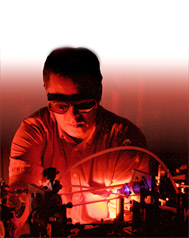About LANL
About Our Capabilities, Facilities, and Staff
"Los Alamos National Laboratory plays an indispensable role in building America as a science and technology powerhouse, and our staff are an incredible resource to the nation and the world." Michael Anastasio, Dir.
Solving Complex R&D Problems with Special Blend of Staff, Capabilities and Facilities
Now in its seventh decade, LANL remains among a very few laboratories that can bring great breadth of fundamental and discovery science, technology, and engineering rapidly together to create tangible solutions for national security needs.
Our staff, working with partners throughout science and industry, must be able to deliver today's solutions while maintaining the depth of capabilities to deliver the next generation of discoveries.
Los Alamos has demonstrated a cycle of innovation where we have developed world-leading capabilities and facilities in response to urgent, unique missions. We also spin out new discoveries that lead to emerging missions.
Being able to integrate and apply our capabilities rapidly to new challenges will be a key advantage in an increasingly competitive landscape.
Our Science, Technology and Engineering Priorities
Science that Matters
- Information science and technology enabling integrative and predictive science
- Experimental science focused on materials for the future
- Fundamental forensic science for nuclear, biological, and chemical threats
How We Work
- Collaborate, partner and team to make decisive contributions to our sponsors
- Outstanding operational excellence for safety, security, and efficient pursuit of ST&E for our missions
Transform Our Scientific Campus
- Campus for 2020 (consistent with complex transformation)
- Modern science facilities: LANSCE refurbishment, CMR replacement, Science Complex
- Signature facilities for experimental science (MaRIE) and computational science (Roadrunner)
More About This Science
3D Simulations May Solve Conflicting Interpretations About Ribosomes
Nanotechnology Discovery Saves Lives
Largest biological simulation provides genetic answers to aid medicine

Quick read
New medicines that save lives by combating drug-resistant bacteria —such as Staph (Staphylococcus aureus) —are just one of the results of the largest biological simulation ever.
Nanoscience—the study of things of "little" importance, one might quip—led to the largest biological simulation ever, which helped Los Alamos scientists decode genetic information. The methodology paved the way for developing new antibiotics and modeling the entire protein synthesis process—a process crucial to saving lives.
The body comprises enumerable nanofactories called ribosomes that work overtime to keep us alive. In each of our trillions of cells, a million ribosomes create proteins—chains of amino acids—that are the basis of life. A quintillion protein factories rebuild our entire body every seven years.
Ribosome study is nothing new but, "only now we can use supercomputers to investigate, in atomic detail, how this very complex machine really works," says Los Alamos National Laboratory theoretical biologist Kevin Sanbonmatsu. "It has been the holy grail and now our team at Los Alamos is making it happen."
Sanbonmatsu and Theoretical Biology and Biophysics Group Leader Chang-Shung Tung created the first atomic-level computer model of a single ribosome.
Sanbonmatsu and his team hope their 3D simulations can solve conflicting interpretations about ribosomes. Secondly, this technology will provide information required to design new medicine to combat drug-resistant bacteria, such as the prevalent Staph (Staphylococcus aureus), which causes many diseases and fatal infections such as food poisoning.
The Molecular-Dynamics Code
A ribosome's base parts were a mystery not too long ago, until 2000 when researchers solved the 3D atomic-level structure of each of the ribosome's two subunits. This research inspired Sanbonmatsu and Tung, who fit these asymmetrical subunits into a single mathematical representation and built a computer code to represent how the constituent atoms and molecules interact. They soon used their simulation work to find the tRNA's route into the rat's nest of the ribosome.
Their first model was the largest biomolecular-dynamics simulation ever done, encompassing more than 2.5 million atoms. Sanbonmatsu was warned this project was too ambitious for a newcomer, but he disproved critics and won a federal Presidential Early Career Award for Scientists and Engineers.
Sanbonmatsu's team's simulation computed the forces among atoms to determine the path of least resistance—the minimum-energy path. Viewing the results was extraordinarily time-consuming. After months of staring at each frame, viewing every atom, he found the invisible entry channel. Only 68 of the ribosome's 5,000 amino acids interacted with tRNA during entry at a ribosomal gate; the simulation revealed the end of the tRNA with the attached amino acid was deflected to avoid the barrier and get inside the ribosome's interior. In short, the model exposed how a ribosome rejects the wrong tRNA. For the first time, researchers learned that tRNA delivered important genetic information. Additionally, this data suggests tRNA might have existed long before the ribosome, facilitating protein synthesis in pre-life systems.
Important Nanotechnology Developments
While the origin of its name is miniscule—a billionth of a part, the core of atoms—nanotechnology is an extraordinary part of everyday life. There are some 600 commercial products available (e.g., cosmetics, sunscreen, clothing, home furnishings, sports, and electronic equipment) where nanotechnology plays a manufacturing role.
Nanoscience enables improvements in medical diagnostics and drug delivery, bioscience, chemical sensing, military platforms, and nuclear defense systems and even helped Los Alamos National Laboratory (LANL) create a supreme superconductor. Sanbonmatsu's team is also preparing a new ribosomal simulation code for Roadrunner, LANL's world's most powerful computer.

Table-top lasers compete with large accelerators
George Rodriguez adjusts argon gas pressure inside two-color plasma ionization gas cells
Table-top ultrafast laser based plasma terahertz sources are beginning to rival pulse energies previously obtainable only at large accelerator-based facilities.
Currents, the Laboratory's monthly employee magazine, highlighting people in the workplace.







